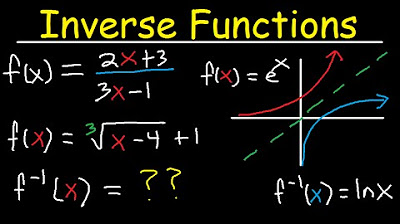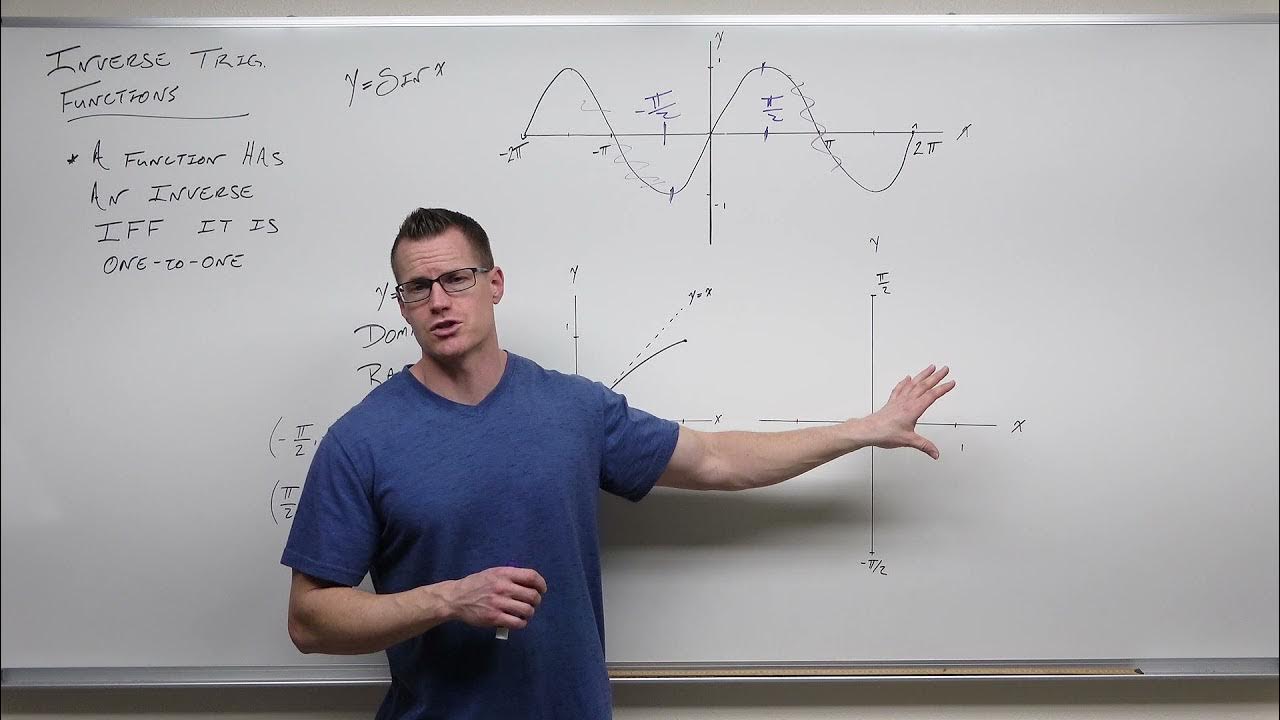Functions
TLDRThe video script presents a series of mathematical problems involving function calculations, inverse functions, and graph analysis. It demonstrates how to compute the value of functions for specific inputs, derive inverse functions through algebraic manipulation, and identify the domain of composite functions. The script also explains how to verify if two functions are inverses of each other and how to determine if a function is one-to-one based on the horizontal and vertical line tests. The step-by-step solutions are detailed, enhancing the understanding of function properties and algebraic problem-solving techniques.
Takeaways
- 📝 The process of evaluating a function at a specific value involves substituting the value into the function's formula and simplifying the result.
- 🔄 To find the inverse function, replace the function notation (f(x) with y), switch x and y, and solve for y, which gives the inverse function's formula.
- 🔢 When solving for x in a function, isolate x by moving terms around and factoring when necessary to find the value(s) of x.
- 🔍 To determine if two functions are inverses, show that f(g(x)) = x and g(f(x)) = x for all values in their respective domains.
- 📈 Understanding the vertical line test is crucial for identifying whether a graph represents a function; a graph passes the test if every vertical line intersects it at most once.
- 🔄 One-to-one functions are characterized by passing the horizontal line test, meaning each horizontal line intersects the graph at most once.
- 💡 The inverse function of a one-to-one function will always pass the vertical line test, confirming its legitimacy as a function.
- 🧩 Solving for unknown values in a function involves substituting known values and simplifying the equation to find the unknown.
- 📊 The domain of a function is the set of all possible input values (x-values) which produce real output values. It excludes values that would cause undefined expressions.
- 🔢 To find the domain of a quotient of functions, identify and exclude values that would result in a zero denominator, as division by zero is undefined.
Q & A
What is the value of f(2) according to the given function?
-The value of f(2) is 19. This is calculated by substituting x with 2 in the given function, which results in 2^3 + 5*(2^2) - 9. Calculating each term gives 8 + 20 - 9, which sums up to 19.
How is the inverse function derived from the given function?
-To find the inverse function, we replace f(x) with y, switch x and y, and solve for y. This involves eliminating the radical by raising both sides of the equation to the fifth power to cancel out the radical. The final steps involve isolating y on one side of the equation to get the inverse function.
What is the value of x when f(x) is equal to -15?
-When f(x) is -15, we rearrange the equation to solve for x. This involves factoring the quadratic equation after moving all terms to one side. The solutions are x = 4, x = -3, and x = -3/2. However, only x = 4 is listed as an answer choice.
How do we find the composition of functions, f(g(x))?
-To find f(g(x)), we first replace g(x) with its equivalent expression, then substitute this into the function f(x). This involves simplifying and combining like terms to arrive at the final expression for the composite function.
What is the value of g(f(2))?
-The value of g(f(2)) is 6. This is found by first determining f(2), which is -1, and then substituting this value into the function g(x) to find the final result.
How can we prove that two functions are inverses of each other?
-To prove that two functions are inverses, we need to show that f(g(x)) equals x and g(f(x)) also equals x. This involves substituting the functions into each other and simplifying to show that the result is the original variable value.
Which graph is not a function according to the vertical line test?
-Graph C is not a function because it fails the vertical line test. A function must pass the vertical line test, which means that a vertical line should intersect the graph at only one point, and graph C intersects at three points.
Which of the given functions is not one-to-one?
-Function C is not one-to-one because it fails the horizontal line test. A one-to-one function must pass the horizontal line test, meaning that a horizontal line should intersect the graph at only one point, but function C intersects at two points.
If f(4, y) is 48, how do we find the value of y?
-Given that f(4, y) is 48, we can solve for y by substituting x with 4 in the function and simplifying the resulting equation. After dividing all terms by 2 and factoring, we find that y can be either -8 or 2. Since 2 is the listed answer choice, it is the correct value for y.
What is the domain of the function (f/g)?
-The domain of the function (f/g) is all real numbers except -5 and 3. This is because the denominator of the fraction cannot be zero. We find the values that make the denominator zero by factoring the denominator and ensuring that x does not equal -5 or 3.
Outlines
📚 Calculating Function Values and Inverse Functions
This paragraph explains the process of calculating function values and finding inverse functions. It begins with an example of finding the value of a function f at x=2, which involves substituting x with 2 in a given expression and simplifying it to get the result 19. The paragraph then describes how to find the inverse function by replacing f(x) with y, switching x and y, and solving for y. It also covers solving for x when f(x) is given as -15, which involves rearranging the equation and factoring. A key concept discussed is the evaluation of composite functions, such as f(g(x)), and how to find the value of a composite function by substituting the function's output into another function. The importance of understanding when functions are inverses of each other is also emphasized, with a clear explanation of the necessary conditions and a method to prove it using specific examples. The paragraph concludes with an explanation of how to find the domain of a quotient of two functions, emphasizing the need to exclude values that would make the denominator zero. The process of factoring and simplifying expressions to determine the domain is outlined, and the final answer is provided in interval notation.
📐 Understanding One-to-One Functions and Their Inverses
This paragraph delves into the concept of one-to-one functions and their properties. It starts by explaining the horizontal line test to determine if a function is one-to-one; a function passes this test if a horizontal line intersects the graph at only one point. The paragraph then discusses the implications of a function being one-to-one, which is that its inverse function exists and is also a function. This is because the inverse function must pass the vertical line test. The content continues with an example of identifying which of the given graphs is not a function by applying the vertical line test. It is shown that options A, B, and D pass the test, while option C fails, indicating that it is not a function. Further, the paragraph explains how to identify non-one-to-one functions using the horizontal line test. It is demonstrated that while options A, B, and D pass this test, option C fails, showing that it is not a one-to-one function. The paragraph also discusses the properties of the inverse function of a non-one-to-one function, explaining why it would not be a function. The summary concludes with a problem-solving example where the value of y is found given a function f(x, y) = 48, and the process of simplifying and solving a quadratic equation to find the value of y is detailed.
🔢 Domain of a Function and Quotient of Functions
This paragraph focuses on the concept of the domain of a function and how to find it, especially in the case of a quotient of two functions. It begins by defining the domain as all real numbers except for those values that would cause a division by zero in the function. The process of finding the domain of the quotient of functions f(x)/g(x) is explained, where f(x) and g(x) are given as specific expressions. The first step involves setting the denominator equal to zero and factoring it to find the values of x that are not in the domain. The paragraph then provides the solution by identifying the values of x that cause the denominator to be zero and thus are excluded from the domain. The final answer is presented in interval notation, clearly stating the range of x values that are included in the domain of the function f(x)/g(x). Overall, this paragraph emphasizes the importance of understanding the domain of a function for its proper application and manipulation, and it provides a clear methodology for determining the domain in cases of function division.
Mindmap
Keywords
💡Function
💡Inverse Function
💡Algebraic Manipulation
💡Factoring
💡Composition of Functions
💡Domain
💡Vertical Line Test
💡Horizontal Line Test
💡One-to-One Function
💡Graphs
💡Solving Equations
Highlights
Calculation of function value by substituting x with 2, involving exponentiation and multiplication.
Derivation of the inverse function by replacing f(x) with y, switching x and y, and solving for y, including the elimination of a radical.
Solving for x when f(x) equals a negative value, involving moving terms and factoring a quadratic equation.
Application of substitution and simplification to find the value of f(g(x)) and g(f(x)), demonstrating the concept of composite functions.
Verification of whether two functions are inverses of each other by showing that f(g(x)) equals x and g(f(x)) equals x.
Identification of non-function graphs based on the failure of the vertical line test.
Determination of non-one-to-one functions using the horizontal line test and the implications for the existence of an inverse function.
Solving for y when given f(4, y) equals 48, involving factoring and solving a quadratic equation.
Explanation of the domain of a quotient of two functions, including the conditions that the denominator cannot be zero.
Use of interval notation to express the domain of a function, demonstrating mathematical notation and its application.
Comprehensive approach to solving mathematical problems involving functions, showcasing the application of various mathematical concepts and techniques.
Step-by-step problem-solving method, providing clarity and understanding of complex mathematical operations.
Integration of algebraic manipulation, such as factoring and simplifying, to solve for variables within function expressions.
Explanation of the properties of functions, including one-to-one functions and their inverses, enhancing the understanding of function behavior.
Application of the vertical and horizontal line tests to determine the nature of graphical representations of functions, emphasizing the visual aspect of function analysis.
Use of substitution to evaluate functions at specific points, demonstrating the process of replacing variables with values in function expressions.
Transcripts
Browse More Related Video

Inverse Functions - Domain & range- With Fractions, Square Roots, & Graphs

Verifying Inverse Functions | Precalculus

Introduction to Inverse Trigonometric Functions (Precalculus - Trigonometry 17)

Inverse Functions

One to One Functions (Precalculus - College Algebra 50)

Finding Inverse Functions (Precalculus - College Algebra 51)
5.0 / 5 (0 votes)
Thanks for rating: